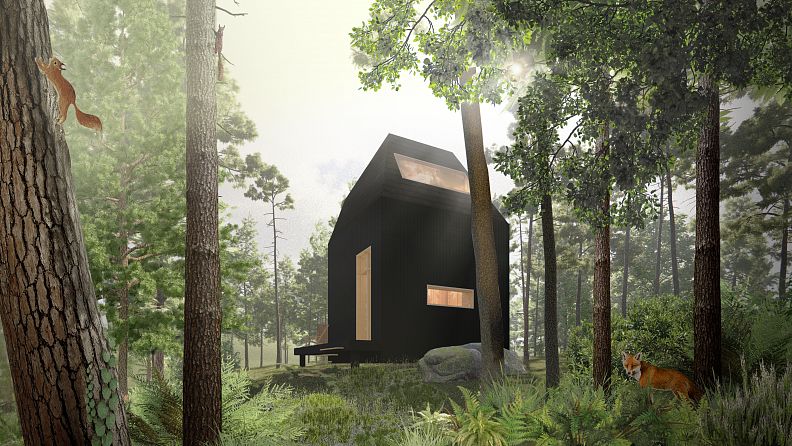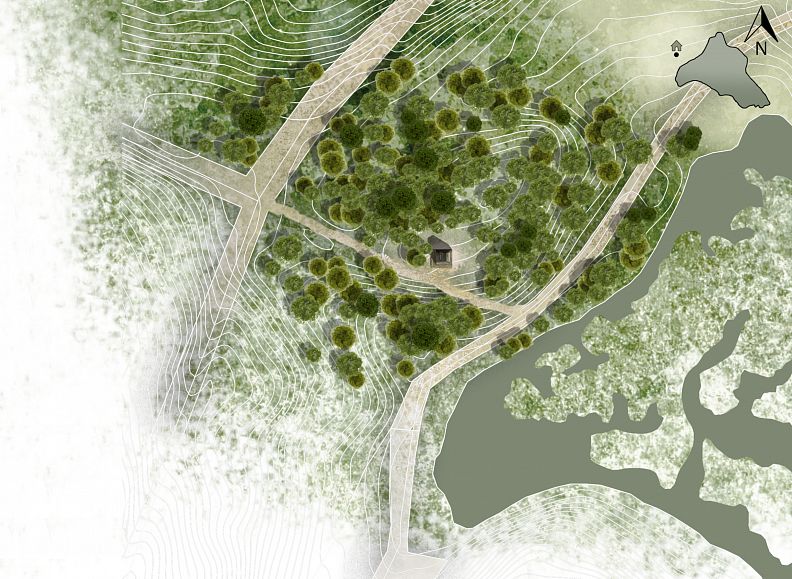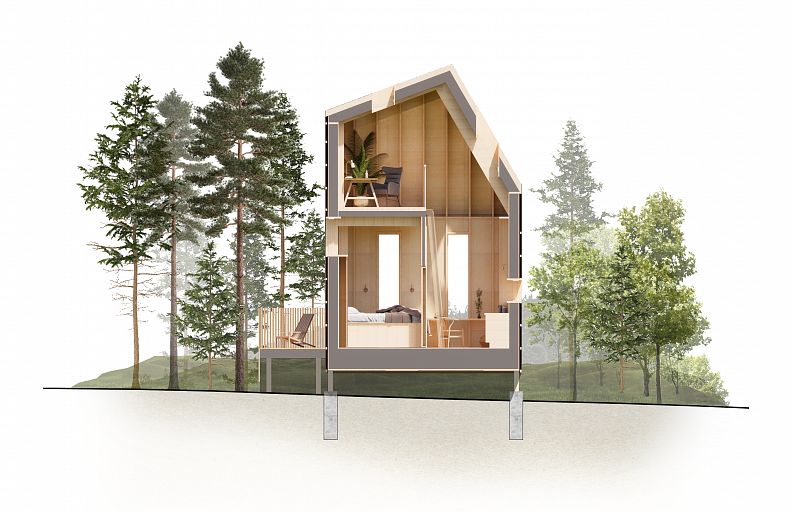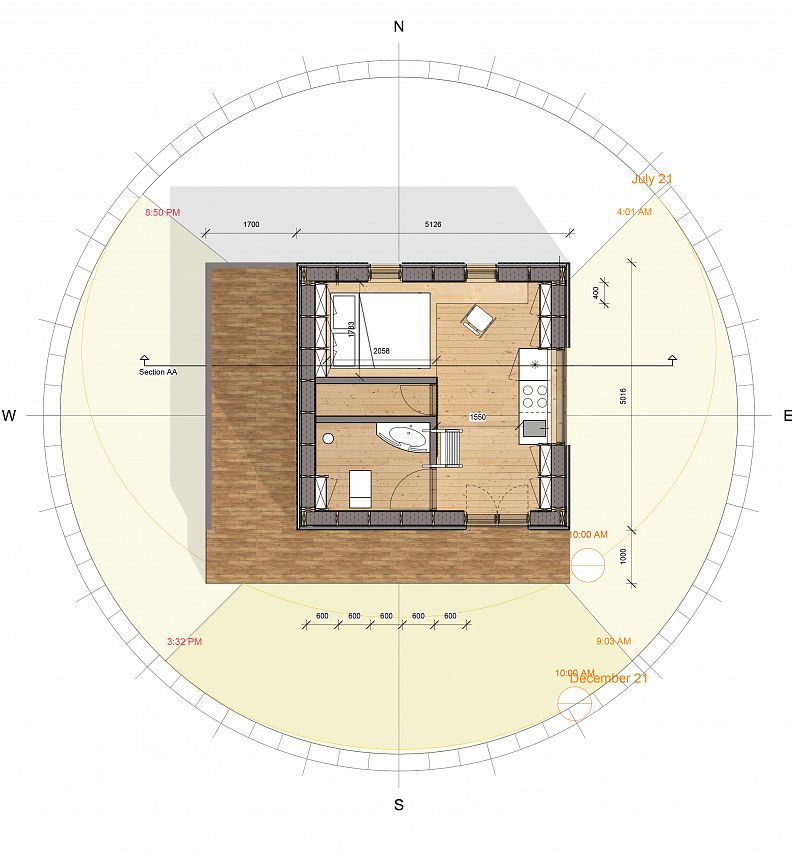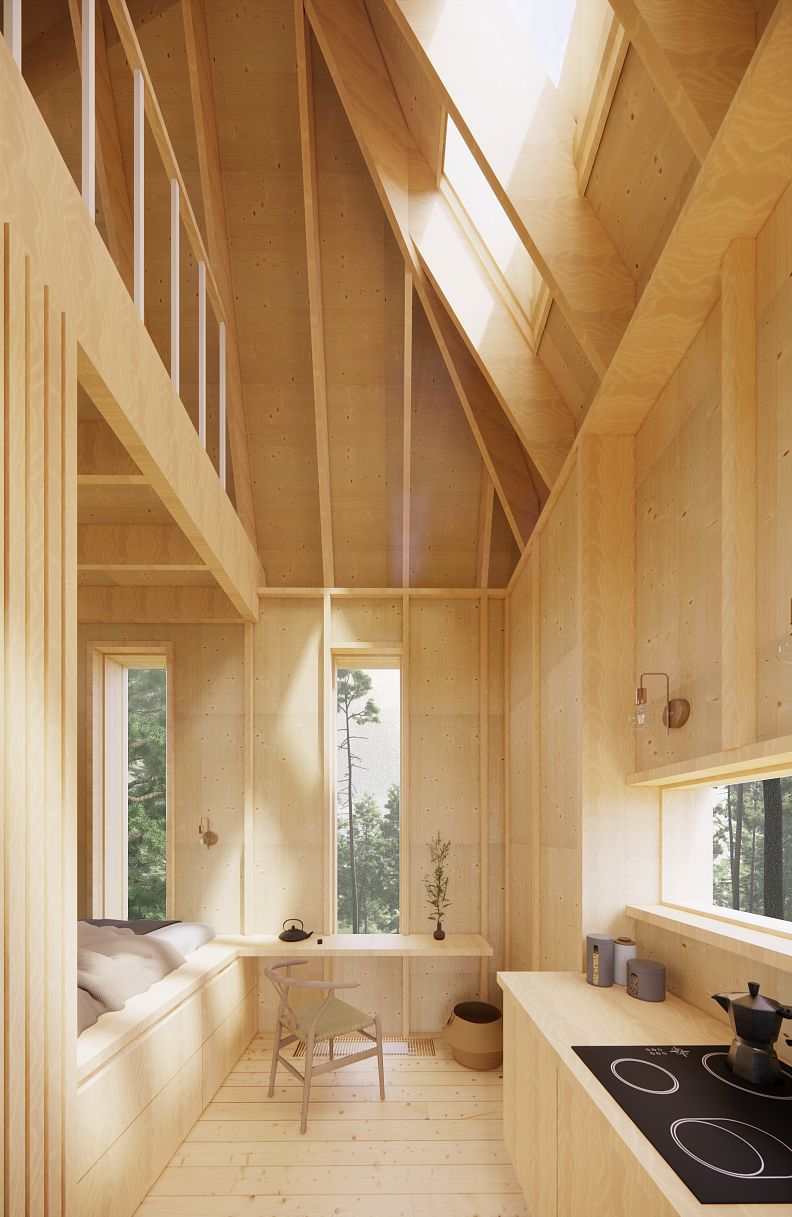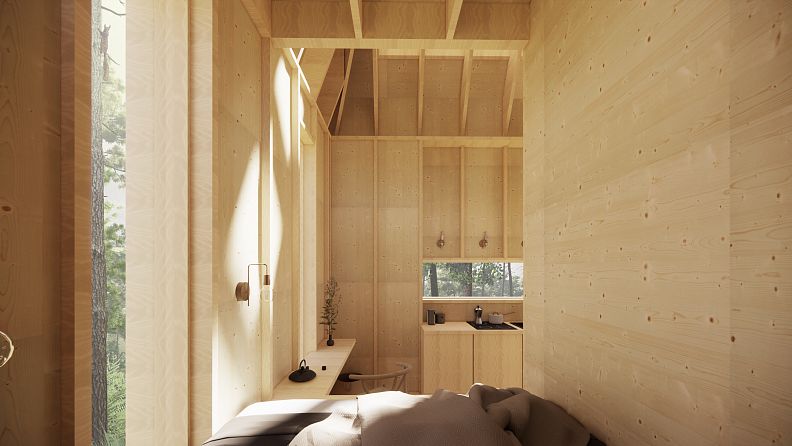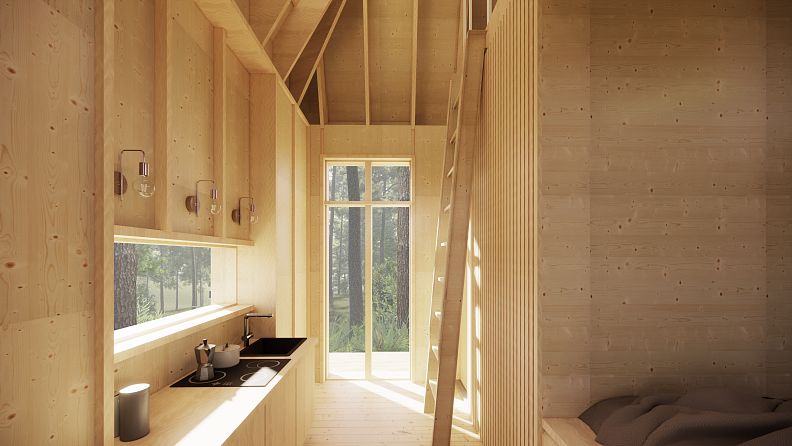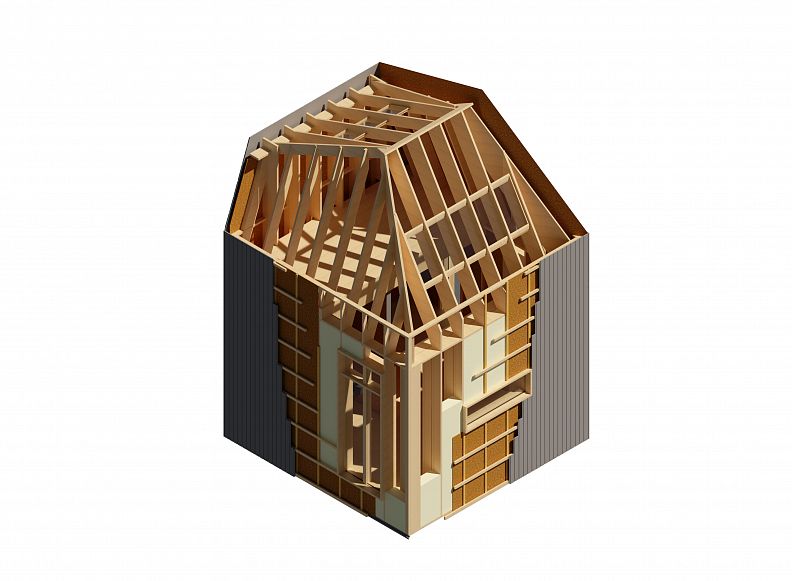Black Monolith - Cabin in the woods

Project idea
CONTEXT
Proposed is a retreat for a writer who wants to work remote from society and close to nature for some weeks or a few months in order to contemplate and concentrate, eventually seeking inspiration from nature. The retreat relates both practically and poetically to the place it is situated: aiming to address the human sense of vision, touch and movement (the kin-aesthetic sense), eg. by using principles of biophilic design. "The Black Monolith" retreat sits on the hill West from Pebermosen lake, surrounded by dense forests of Hammer Bakker, North Denmark Region. The unusual topography is a remain after the glacial period resulting in rolling hills and a lake in the depression. It makes it unique in the context of typical Danish landscape. The cabin design is a result of Advanced Integrated Design - sustainable-tectonic design with integrating of structure, site and climate conditions.
Project description
FUNCTIONALITY
All cabin functions are laid out on a very small area of only 27.9 m2 - small living considerations were very important for the design of the retreat - allowing for freedom with how the space can be utilized. Minimal furnishings include a bed with built-in drawers for extra storage. Bed plate later transforms into a small table that can serve as extra working space or dining area. Furnishing is designed in a flexible way and can serve multiple purposes at the discretion of the cabin guest. A lot of hidden storage space is incorporated in the interior design. There are push-to-open wardrobes hidden in the walls. Large sliding door mounted on the middle wall and hidden behind the ladder can easily divide spaces by separating sleeping and living areas if needed. Sleeping area is facing the North which contributes to optimal sleeping conditions.
PARADOXICAL EXPRESSION
The building brings to mind a black monolith when seen from a far but, paradoxically, after approaching it closer one can notice it is actually not even close to a solid rock, but it appears to be a light wooden construction instead and after getting inside it opens up into very light, airy and soaked with sun interior. The constrast is clear.
When it comes to relation to nature, with its solid shape and onyx color the cabin clealy does not constitute of a natural element. It appears as if it was a shadow emerging from between the trees. The building does not overshadow the landscape, but instead embraces it by contrast and simultaneously, becomes a distinct mysterious object thrown into the existing surrounding beauty.
CONTRASTING MATERIALS
EXTERIOR of the cabin is kept in a very dark color theme.
Walls are covered with charred wood cladding - applying an old method of wood treatment (Shou Sugi Ban) originated from Japan, which does not only look elegant, but also acts as a natural preservation of the wood. Burned wood has a long life span if conducted properly, with Japanese examples of Shou Sugi Ban lasting for well over 50 years.
Roof is covered with durable black slates made of metamorphic rocks which are derived from sedimentary rock of volcanic ash and clay. Natural slating offers a very long lifespan, good fire protection and an invulnerability to rot or insect damage, all of which ensures a very low-maintenance roofing solution. Slates are laid in combination with SolteQ Infinity monocrystalline solar panels in color “anthracite” with efficiency of 20.2%. Chosen panels allow to fulfill energy demands and, at the same time, achieve very seamless and non distinctive look.
INTERIOR is entirely made from wood in light colors, which remarkably contrasts with the exterior. Hoop pine plywood was used for the joinery, wall, and ceiling cladding. All elements of the design were prefabricated with the exception of the flooring to aid in erection and possible disassembly.
MULTISENSORY STIMULATION
VISION
The cabin provides variable options for visual experience. Elongated window facing East gives an opportunity for the morning light in the kitchen area and provides a magnificent view for the Pebermosen lake. Terrace on the West is soaked with afternoon sun and gives a view for the most magical area of the site - gently rolling landscape covered with moss and forested with conifers. Tall windows facing North give a glimpse for unusual collision - where two different forest types, spruce and beech, are meeting. Such scenario will assure an interesting, multicolor view all year round. It is also possible to see through the cabin from South to North and vice versa. The view clean through the building dissolves the boundaries between inside and out.
SMELL
Since the cabin is almost entirely constructed from wood that naturally contains healing essential oils, it emits a pleasant scent for years and years diffused into indoors.
TOUCH
Variety of surfaces used in the cabin provides the guest not only with visual stimulation, but also adresses the aspect of touch. Rough and polished, cold and warm - these are just a few finishes to be met in the cabin.
SOUND
The cabin is located in the forest and in the most natural way benefits from its beauty. Rustling leaves, creaking boughs, singing birds - sounds of nature surround the retreat, which truly make the atmosphere unique.
KIN-AESTHETICS
The retreat sits on top of the hill - a bit further from main pathways, which makes it harder to reach. On the other hand there is a narrow green alley leading uphill to the cabin, which seems nearly inviting to climb up. It is worth taking a hike through the forest to reach the top of the hill.
BIOPHILIC DESIGN
When using the Natural Materials biophilic design principle it is a good idea to involve unprocessed wood in a project. It is due to the fact that it does not only reflect light in a special, impossible to be replicated way, but also due to the smell it can effuse. Essential oils found inside the wood have a big potential to reduce blood pressure, lower the heart rate and promote a healthier immune system. It happens thanks to antimicrobial phytoncides like limonene, that possess anti-inflammatory and antioxidant (natural cancer cells fighting) properties. The benefits of natural materials are endless. From enhancing human ability to absorb information from the environment to increasing healing abilities and creativity levels. Alike real forest visit, untreated wood used indoor was shown to have a potential to reduce both physical and mental stress.
Technical information
SELF-SUFFICIENCY, VENTILATION STRATEGY, ENERGY USE
The retreat encompass a cabin with a gross area of 40m2 with the opportunity to place a 1 x 2 meter working table with calculated adequate diffuse light, and a terrace with a horizontal area of 15 m2 for work and outdoor residence. The retreat enables living and working all year round and provides fine opportunities for natural ventilation. Windows are placed on each side of the cabin, which allows to establish desired air flow through the building - depending on the current climate conditions cross or single-sided ventilation can be applied. It is also possible to establish air flow in between both floors - following the chimney effect. The cabin enables low energy consumption (14.3 kWh per m2 per year) for heating achieved by passive means. Energy consumption for hot water estimates to 800 kWh/year and for electrical appliances 1000 kWh/year. All energy use is covered by photovoltaics. The energy generated from photovoltaics is stored in a battery. The retreat is off-grid and all necessities are carried by foot for some hundred meters, just as waste is carried away or recirculated. There is a water-well on the site.
SOLAR ENERGY
The cabin benefits from the most sunny glade in the surrounding. Chosen solution of solar cells covers area of 11.8 + 10.26 m2. The larger area is aimed directly towards South at an angle of 70°, close to ideal winter angle (64°). The smaller area is aimed towards East at an angle of 60°. The angle and orientation of the panels is optimized for harvesting as much energy as possible during critical winter months. Trees in the further background on South-East side of the cabin are deciduous, shedding its leaves annually and therefore clearing up the sky, which contributes to improved solar access during winter. Additionally bigger windows are positioned towards South and West in order to benefit from passive solar gain.
MODULAR DESIGN
Design for the cabin is primarily dictated by visible construction inside. The whole building is composed from modular timber studs making it very regular and easy to implement in the execution phase. All openings are fitting the modular grid and windows, doors and skylights used are meeting the certification of Passive House Insitute. It was extremaly important to design variety of windows in order to provide diverse light and view at different times of the day, but at the same time meet the challenges of energy frame and optimal indoor climate achieved by passive and active strategies.
CONSTRUCTION
The retreat is constructed mostly by wood. Metals or concrete are used only for minor purposes and the use is well argued. In between wooden structural stud frame, high class wood fibre insulation is applied. OSB boards are covering the structure, sheltering from wind. Vertical distance strips and horizontal battens create a support system for the cladding and create a space to allow the air flow and ventilate the construction. There is also a Z profile and corrugated steel band in the bottom of wall elements to prevent rodents from entering the construction.
Additionally the aim was to design a structure that would not have any physical footprint on the nature. The highest priority was placed on reducting the impact of this cabin on its natural environment. Almost all trees on the site were intentionally preserved and the structure was lifted up to protect the ground beneath. Concrete pads were designed to support the cabin with minimal disturbance to the soil.
SOFTWARE USED
The cabin was modeled using Autodesk Revit 2020. Visualizations were done in Enscape and later processed in Adobe Photoshop. Analysis were done in Grasshopper for Rhino 6 and VELUX Daylight Visualizer 3, and energy frame was calculated in BE18.
